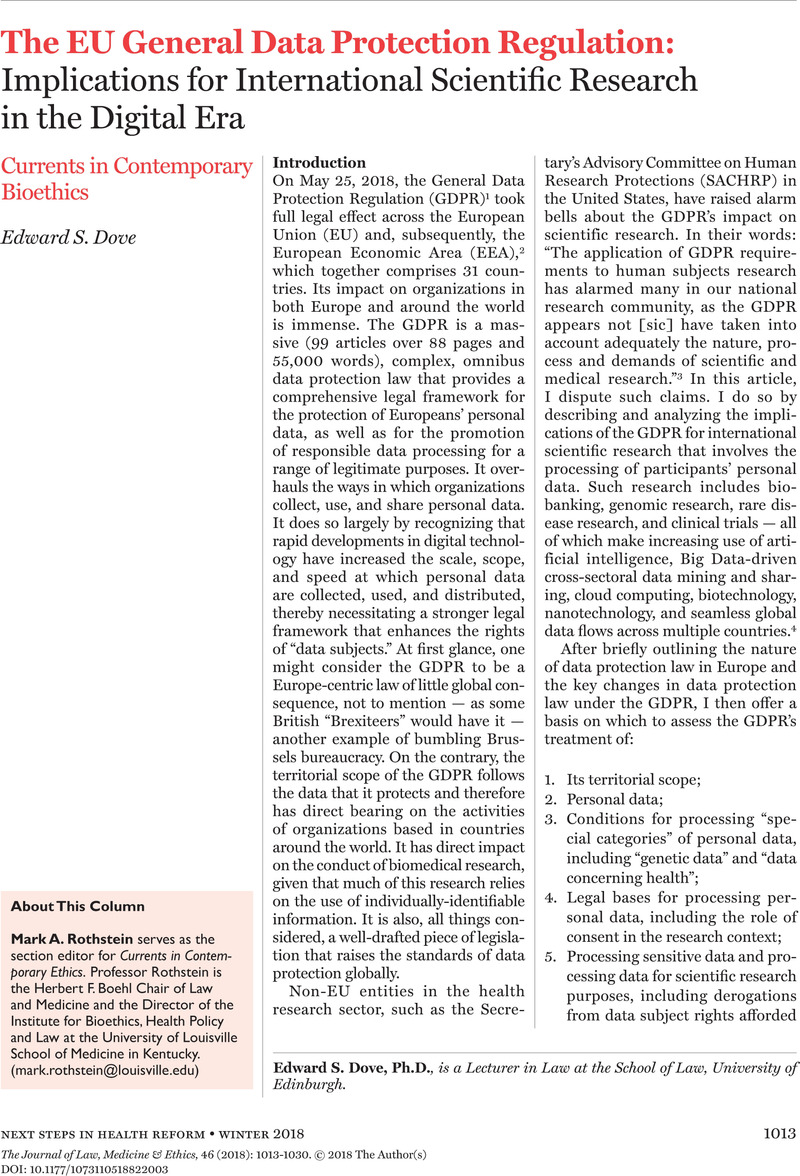Crossref Citations
This article has been cited by the following publications. This list is generated based on data provided by Crossref.
Phillips, Mark
and
Knoppers, Bartha M.
2019.
Whose Commons? Data Protection as a Legal Limit of Open Science.
Journal of Law, Medicine & Ethics,
Vol. 47,
Issue. 1,
p.
106.
Rothstein, Mark A.
and
Tovino, Stacey A.
2019.
California Takes the Lead on Data Privacy Law.
Hastings Center Report,
Vol. 49,
Issue. 5,
p.
4.
Saunders, Gary
Baudis, Michael
Becker, Regina
Beltran, Sergi
Béroud, Christophe
Birney, Ewan
Brooksbank, Cath
Brunak, Søren
Van den Bulcke, Marc
Drysdale, Rachel
Capella-Gutierrez, Salvador
Flicek, Paul
Florindi, Francesco
Goodhand, Peter
Gut, Ivo
Heringa, Jaap
Holub, Petr
Hooyberghs, Jef
Juty, Nick
Keane, Thomas M.
Korbel, Jan O.
Lappalainen, Ilkka
Leskosek, Brane
Matthijs, Gert
Mayrhofer, Michaela Th.
Metspalu, Andres
Navarro, Arcadi
Newhouse, Steven
Nyrönen, Tommi
Page, Angela
Persson, Bengt
Palotie, Aarno
Parkinson, Helen
Rambla, Jordi
Salgado, David
Steinfelder, Erik
Swertz, Morris A.
Valencia, Alfonso
Varma, Susheel
Blomberg, Niklas
and
Scollen, Serena
2019.
Leveraging European infrastructures to access 1 million human genomes by 2022.
Nature Reviews Genetics,
Vol. 20,
Issue. 11,
p.
693.
Becker, Regina
Alper, Pinar
Grouès, Valentin
Munoz, Sandrine
Jarosz, Yohan
Lebioda, Jacek
Rege, Kavita
Trefois, Christophe
Satagopam, Venkata
and
Schneider, Reinhard
2019.
DAISY: A Data Information System for accountability under the General Data Protection Regulation.
GigaScience,
Vol. 8,
Issue. 12,
Alnajrani, Hussain Mutlaq
and
Norman, Azah Anir
2020.
The Effects of Applying Privacy by Design to Preserve Privacy and Personal Data Protection in Mobile Cloud Computing: An Exploratory Study.
Symmetry,
Vol. 12,
Issue. 12,
p.
2039.
Morrison, Michael
Mourby, Miranda
Gowans, Heather
Coy, Sarah
and
Kaye, Jane
2020.
Governance of research consortia: challenges of implementing Responsible Research and Innovation within Europe.
Life Sciences, Society and Policy,
Vol. 16,
Issue. 1,
Tokarski, Mirosław
2020.
Protection of Individuals in the light of EU Regulation 2016/679 on the Protection of Natural Persons with Regard to the Processing of Personal Data and on the Free Movement of such Data.
Safety & Defense,
Vol. 6,
Issue. 2,
p.
63.
Marelli, Luca
Lievevrouw, Elisa
and
Van Hoyweghen, Ine
2020.
Fit for purpose? The GDPR and the governance of European digital health.
Policy Studies,
Vol. 41,
Issue. 5,
p.
447.
Gahoonia, Simy Kaur
Ferreira, Pedro
Cohn, Marisa
Henriksen, Line
Kjær, Katrine Meldgaard
Hockenhull, Michael
Cakici, Baki
Blønd, Marie
Douglas-Jones, Rachel
Laursen, Cæcilie Sloth
and
Zell, Sonja
2020.
Upon Not Opening The Black Box.
p.
1.
Ducato, Rossana
2020.
Data Protection, Scientific Research, and the Role of Information.
SSRN Electronic Journal ,
Fletcher, Isabel
Birko, Stanislav
Dove, Edward S.
Laurie, Graeme T.
McMillan, Catriona
Postan, Emily
Sethi, Nayha
and
Sorbie, Annie
2020.
Co-production and Managing Uncertainty in Health Research Regulation: A Delphi Study.
Health Care Analysis,
Vol. 28,
Issue. 2,
p.
99.
Dove, Edward S.
and
Chen, Jiahong
2020.
To What Extent Does the EU General Data Protection Regulation (GDPR) Apply to Citizen Scientist-Led Health Research with Mobile Devices?.
Journal of Law, Medicine & Ethics,
Vol. 48,
Issue. S1,
p.
187.
Becker, Regina
Thorogood, Adrian
Ordish, Johan
and
Beauvais, Michael J.S.
2020.
COVID-19 Research: Navigating the European General Data Protection Regulation.
Journal of Medical Internet Research,
Vol. 22,
Issue. 8,
p.
e19799.
Ducato, Rossana
2020.
Data protection, scientific research, and the role of information.
Computer Law & Security Review,
Vol. 37,
Issue. ,
p.
105412.
Narayanasamy, Shaman
Markina, Varvara
Thorogood, Adrian
Blazkova, Adriana
Shabani, Mahsa
Knoppers, Bartha M.
Prainsack, Barbara
and
Koesters, Robert
2020.
Genomic Sequencing Capacity, Data Retention, and Personal Access to Raw Data in Europe.
Frontiers in Genetics,
Vol. 11,
Issue. ,
Lin, Jui-Chu
Hsiao, Wesley Wei-Wen
and
Fan, Chien-Te
2020.
Transformation of the Taiwan Biobank 3.0: vertical and horizontal integration.
Journal of Translational Medicine,
Vol. 18,
Issue. 1,
Garrett-Ruffin, Sherona
Hindash, Alexandra Cowden
Kaczkurkin, Antonia N.
Mears, Ryan P.
Morales, Santiago
Paul, Katharina
Pavlov, Yuri G.
and
Keil, Andreas
2021.
Open science in psychophysiology: An overview of challenges and emerging solutions.
International Journal of Psychophysiology,
Vol. 162,
Issue. ,
p.
69.
Gaille, Marie
and
Horn, Ruth
2021.
The ethics of genomic medicine: redefining values and norms in the UK and France.
European Journal of Human Genetics,
Vol. 29,
Issue. 5,
p.
780.
Pawlicka, Aleksandra
Choraś, Michał
Przybyszewski, Marcin
Belmon, Laurent
Kozik, Rafał
and
Demestichas, Konstantinos
2021.
Computer Information Systems and Industrial Management.
Vol. 12883,
Issue. ,
p.
331.
Nordberg, Ana
2021.
GDPR and Biobanking.
Vol. 43,
Issue. ,
p.
61.



